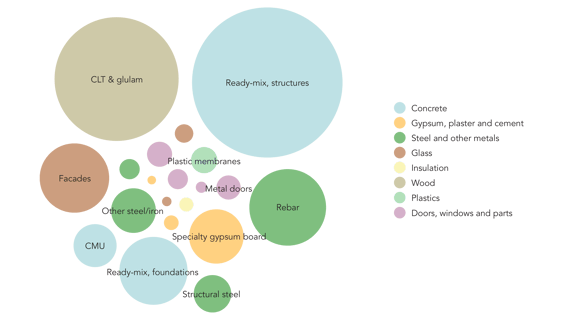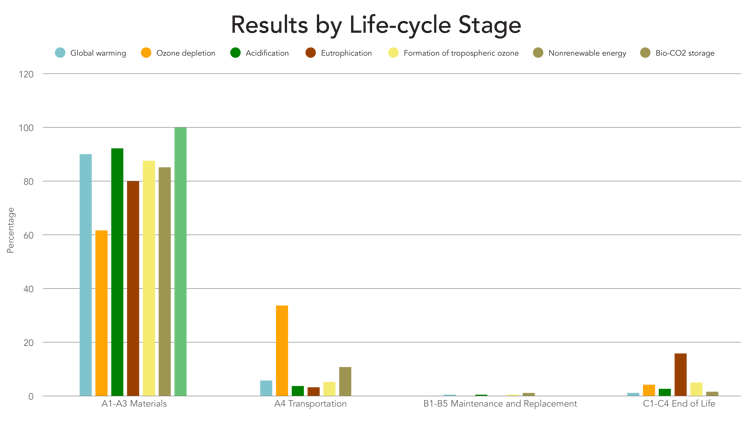Cranes erecting buildings are a universally accepted sign of a healthy economy. While many will say that an already existing building is the most sustainable building, the emergence of new buildings on previously developed land or greenfields is an important part of the development landscape.
What is new(er) today is a debate about how best to build new buildings – as measured by environmental impact. After all, according to the UN, buildings and construction account for 39% of total global C02 emissions. UN data also suggest that, globally, building energy performance needs to improve by 30% by 2030 to keep up with the Paris Climate Agreement.
Buildings and the construction industry can reduce CO2 emissions by improving the construction process and carefully selecting building materials to achieve a better outcome. Knowing what materials to select or when goals are reached is where development teams can look for help from a Building Life-Cycle Assessment.
How a Building Life-Cycle Assessment Can Help Developers
A Building Life-Cycle Assessment (BLCA) is a software model that measures the environmental costs and impacts of a specific building’s structure by evaluating the materials used to build it. The software model takes inputs from the project’s drawing files (easiest with REVIT) and important material ingredient information from product specification documents. The software generates reports to illustrate how the building performs against a variety of environmental metrics (more on that below).
Leveraging the BLCA to assess environmental costs and evaluate alterative products is best done early in the design process. At this point, the BLCA can be used as a design-assist tool and inform decisions in what materials to use for a building’s structure and enclosure to improve environmental performance and to inform the project’s budget and construction process.
Total Life-Cycle Impact by Resource Type, Global Warming Sample

The first step in conducting a building life-cycle assessment is defining a baseline building in the software after the program is defined. Once the baseline is built, project teams can substitute alternate building materials to see their overall environmental cost and impacts. Environmental costs may not be the only cost savings. Some materials may also have associated structural, aesthetic, labor, shipping, or time costs that must also be considered. Leveraging the integrated design process and working with engineers, estimators, and contractors to evaluate software outputs and findings will generate the best results.
Results by Life-cycle Stage Sample

One example is an analysis comparing a traditional concrete and steel structure to a mass timber structure. Our client, Harbor Bay, explains their approach to selecting mass timber for INTRO Cleveland (featured in the photo above):
“We were initially drawn to Mass Timber, because of its natural beauty and aesthetic allure.”, said Mark Bell, CEO of Harbor Bay Real Estate Advisors (Harbor Bay). “As we researched it further and began our preliminary design phase for INTRO Cleveland, we began to clearly understand that Mass Timber was highly sustainable and would enhance the efficiency of the building, ultimately reducing Greenhouse Gas Emissions. The beauty and sustainability of Mass Timber was embraced by our entire team. It has become a key part of Harbor Bay’s culture."
Why Use a Building Life-Cycle Assessment?
Besides an overall commitment to building a sustainable building, a developer might consider a Building Life-Cycle Assessment for a few other reasons:
PURSUING BUILDING CERTIFICATION
If a project is pursuing LEED Certification, a Building Life-Cycle Assessment can earn the project points—simply conducting the assessment earns a project 1 point. This encourages project teams to start measuring impact, regardless of performance. If performance is beneficial, as defined by the assessment output reports, the project can earn up to 3 more points (or even 4 more points if LEED deems the credit a Regional Priority in the project’s location).
YOUR CLIENTS / CUSTOMERS WANT IT
A life-cycle assessment can be a great marketing tool. Advertising a building having lower environmental costs than the average building can be beneficial to drive new business. People who value sustainability can be very loyal customers by choosing the sustainable option over a competing traditional option. Sustainably minded consumers, renters, and buyers are drawn in by innovation and leadership in the industry.
YOUR INVESTORS DEMAND IT – OR CHOOSE YOU FOR IT
Increasingly, investors require reporting that is informed by data generated from reports like an energy model or a building life-cycle assessment. Socially conscious investment groups and funds may demand data that can only be produced through a BLCA.
What a Building Life-Cycle Assessment Measures
One impact category in a LEED Building Life-Cycle Assessment is global warming potential (also known as CO2 emissions), which usually draws the most focus. However, a BLCA also incorporates other environments impact categories such as eutrophication, acidification of land and water sources, formation of tropospheric ozone, depletion of stratospheric ozone, and depletion of nonrenewable energy sources.
Keywords:
- Greenhouse gas: a gas that absorbs infrared radiation, this heat gets trapped and cannot release out into space. Includes CO2 (the primary greenhouse gas emitted through human activities), methane, nitrous oxide and fluorinated gases.
- Ocean acidification: a reduction in pH caused by the absorption of CO2 from the atmosphere, damaging organisms and the ecosystem.
- Eutrophication: excessive richness of nutrients in water, caused by land runoff, this overproduction of plant life reduces the oxygen available for animal life in these areas and causes bacterial degradation.
- Tropospheric ozone: a major component of smog (which negatively impacts human health), a trace gas caused by a reaction between oxides of nitrogen and volatile organic compounds.
Why keywords matter:
The keywords are all important to understand when considering building life-cycle assessment. A product that releases greenhouse gases has a higher global warming potential than one that does not. By doing a life-cycle assessment and changing materials to those with lower environmental costs, the building improves its sustainable performance.
Who Is Doing Building Life-Cycle Assessments?
For example, developer Harbor Bay leveraged a Building Life-cycle Assessment to evaluate the building structure of INTRO Cleveland—the nation’s tallest (and Cleveland’s first!) mass-timber building currently under construction in Cleveland, Ohio. With careful consideration, the development and design team chose mass timber construction over more traditional steel and concrete because Harbor Bay believes in sustainable development, and the assessment gave them the details to prove the benefit. Harbor Bay was also able to evaluate other design decisions for material selections through the assessment process. INTRO Cleveland is anticipated to open for leasing in Spring 2022.
“As we were designing and seeking the necessary governmental approvals for INTRO Cleveland, we had worked with the University of Dayton and Texas A&M Energy Systems Laboratory to evaluate the efficiency of INTRO’s use of Mass Timber, as designed. At that time, we were deeply encouraged by their estimates of INTRO’s drastic reductions in Greenhouse Gas Emissions. By working with Emerald Built Environments, they introduced us to Building Life Cycle Cost Assessment, as we pursued a LEED GOLD certification. Through this assessment, Emerald Build Environments have demonstrated that INTRO’s reductions in Greenhouse Gas emissions will be far broader than we ever anticipated. It is an amazing feeling to know that you are building a beautiful building for the community and the environment.”, said Bell.
Emerald Built Environments can help you execute your Building Life-Cycle Assessment. Contact us and let's talk about it.
This article was written by Abby McDonald. Abby McDonald, LEED AP BD+C and WELL AP, is a Sustainability Consultant for Emerald Built Environments. In this role, she leads teams seeking LEED and WELL certifications for Emerald.
Posts by Tag
- Sustainability (171)
- sustainability consulting (143)
- Energy Efficiency (126)
- Utilities (91)
- LEED (87)
- Sustainable Design (69)
- green building certification (59)
- energy audit (46)
- ESG (45)
- construction (43)
- GHG Emissions (36)
- WELL (32)
- carbon neutrality (31)
- net zero (27)
- tax incentives (27)
- costs (26)
- energy modeling (18)
- electric vehicles (17)
- Energy Star (14)
- Housing (14)
- Inflation Reduction Act (13)
- water efficiency (13)
- Social Equity (12)
- decarbonization (12)
- diversity (10)
- NGBS (7)
- fitwel (7)
- Earth Day (6)
- electrification (5)
- mass timber (5)
- non-profit (5)
- retro-commissioning (5)
- Emerald Gives (4)
- Engineering (4)
- News Releases (4)
- B Corp (3)
- COVID-19 Certification (3)
- Customers (3)
- Indoor Air Quality (3)
- PACE (3)
- Arc (2)
- DEI (2)
- EcoDistricts (2)
- EcoVadis (2)
- Green Globes (2)
- cannabis (2)
- CDP (1)
- SITES (1)
- furniture (1)
- opportunity zone (1)
- womenleaders (1)


